Strategic Analysis of Sainsbury's and Evaluation of Merger Strategy
VerifiedAdded on 2023/04/21
|28
|5177
|254
Report
AI Summary
This report provides a comprehensive strategic analysis of Sainsbury's, a major UK supermarket chain. It begins with an introduction to Sainsbury's and its market context, followed by an in-depth examination of the external environment using PESTLE analysis, identifying opportunities and threats. The industry analysis employs Porter's Five Forces and complementary analysis to assess industry attractiveness. The report then delves into Sainsbury's internal analysis, evaluating its organizational resources using the VRIO framework, analyzing its competitive advantage, and applying the resource-based view and value chain analysis. A SWOT analysis synthesizes the internal and external assessments. The report evaluates the Sainsbury-ASDA merger strategy using the SAF framework, offering a conclusion summarizing the key findings and strategic recommendations. The report includes various frameworks and models to analyze the case study, highlighting the key drivers of change, competitor analysis, and the strategic group within the hyper-competitive industry.
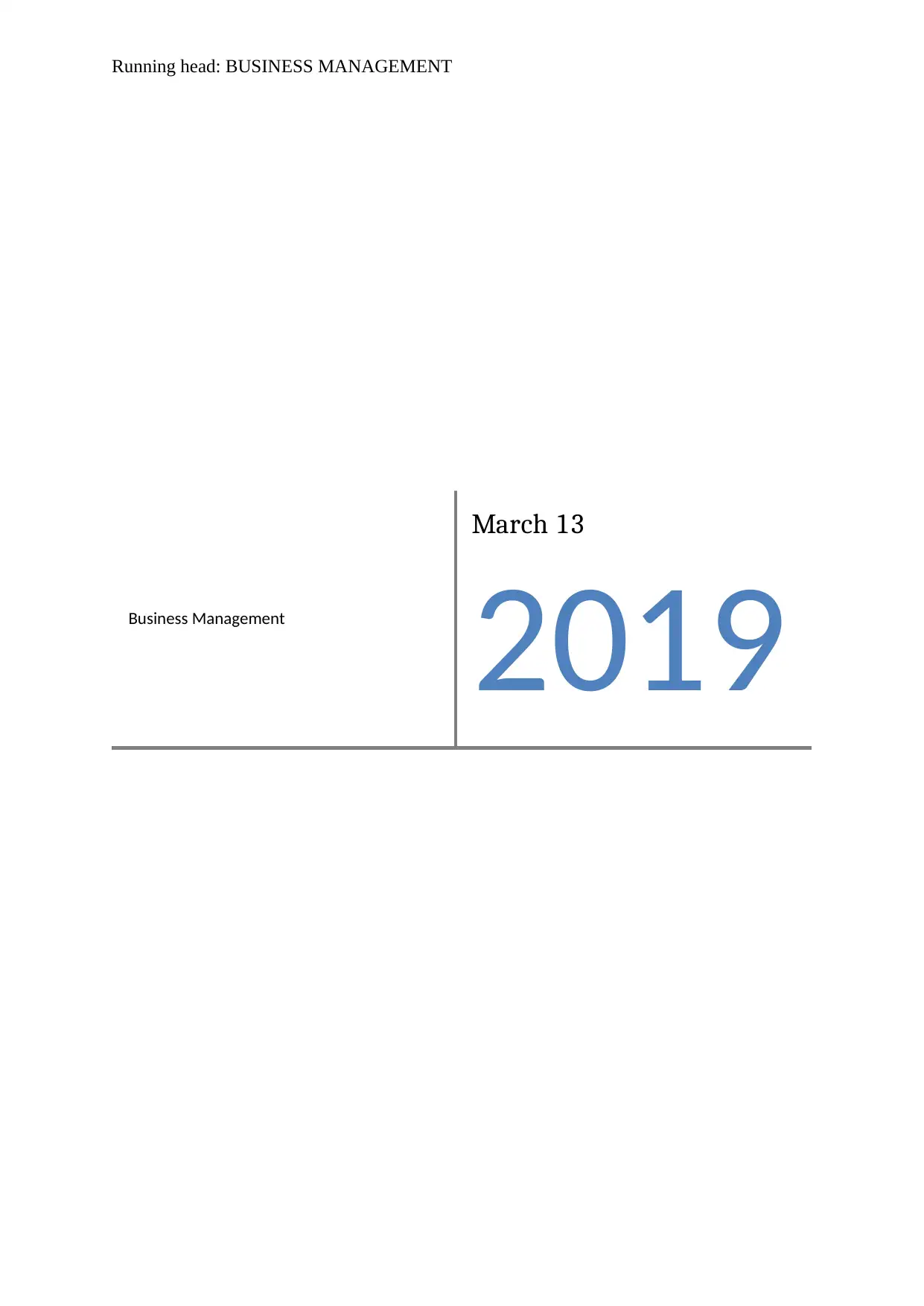
Running head: BUSINESS MANAGEMENT
Business Management
March 13
2019
Business Management
March 13
2019
Paraphrase This Document
Need a fresh take? Get an instant paraphrase of this document with our AI Paraphraser
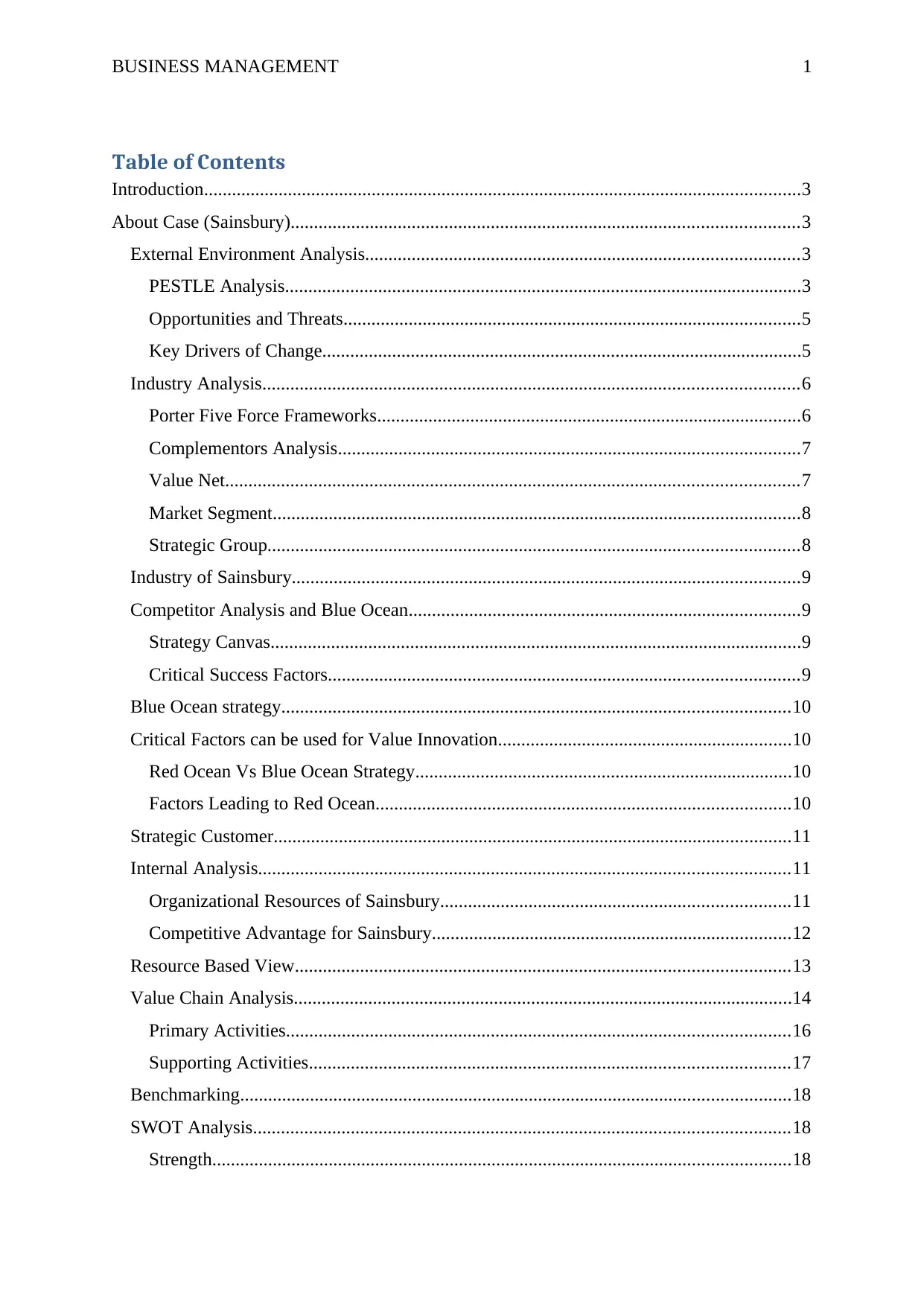
BUSINESS MANAGEMENT 1
Table of Contents
Introduction................................................................................................................................3
About Case (Sainsbury).............................................................................................................3
External Environment Analysis.............................................................................................3
PESTLE Analysis...............................................................................................................3
Opportunities and Threats..................................................................................................5
Key Drivers of Change.......................................................................................................5
Industry Analysis...................................................................................................................6
Porter Five Force Frameworks...........................................................................................6
Complementors Analysis...................................................................................................7
Value Net...........................................................................................................................7
Market Segment.................................................................................................................8
Strategic Group..................................................................................................................8
Industry of Sainsbury.............................................................................................................9
Competitor Analysis and Blue Ocean....................................................................................9
Strategy Canvas..................................................................................................................9
Critical Success Factors.....................................................................................................9
Blue Ocean strategy.............................................................................................................10
Critical Factors can be used for Value Innovation...............................................................10
Red Ocean Vs Blue Ocean Strategy.................................................................................10
Factors Leading to Red Ocean.........................................................................................10
Strategic Customer...............................................................................................................11
Internal Analysis..................................................................................................................11
Organizational Resources of Sainsbury...........................................................................11
Competitive Advantage for Sainsbury.............................................................................12
Resource Based View..........................................................................................................13
Value Chain Analysis...........................................................................................................14
Primary Activities............................................................................................................16
Supporting Activities.......................................................................................................17
Benchmarking......................................................................................................................18
SWOT Analysis...................................................................................................................18
Strength............................................................................................................................18
Table of Contents
Introduction................................................................................................................................3
About Case (Sainsbury).............................................................................................................3
External Environment Analysis.............................................................................................3
PESTLE Analysis...............................................................................................................3
Opportunities and Threats..................................................................................................5
Key Drivers of Change.......................................................................................................5
Industry Analysis...................................................................................................................6
Porter Five Force Frameworks...........................................................................................6
Complementors Analysis...................................................................................................7
Value Net...........................................................................................................................7
Market Segment.................................................................................................................8
Strategic Group..................................................................................................................8
Industry of Sainsbury.............................................................................................................9
Competitor Analysis and Blue Ocean....................................................................................9
Strategy Canvas..................................................................................................................9
Critical Success Factors.....................................................................................................9
Blue Ocean strategy.............................................................................................................10
Critical Factors can be used for Value Innovation...............................................................10
Red Ocean Vs Blue Ocean Strategy.................................................................................10
Factors Leading to Red Ocean.........................................................................................10
Strategic Customer...............................................................................................................11
Internal Analysis..................................................................................................................11
Organizational Resources of Sainsbury...........................................................................11
Competitive Advantage for Sainsbury.............................................................................12
Resource Based View..........................................................................................................13
Value Chain Analysis...........................................................................................................14
Primary Activities............................................................................................................16
Supporting Activities.......................................................................................................17
Benchmarking......................................................................................................................18
SWOT Analysis...................................................................................................................18
Strength............................................................................................................................18
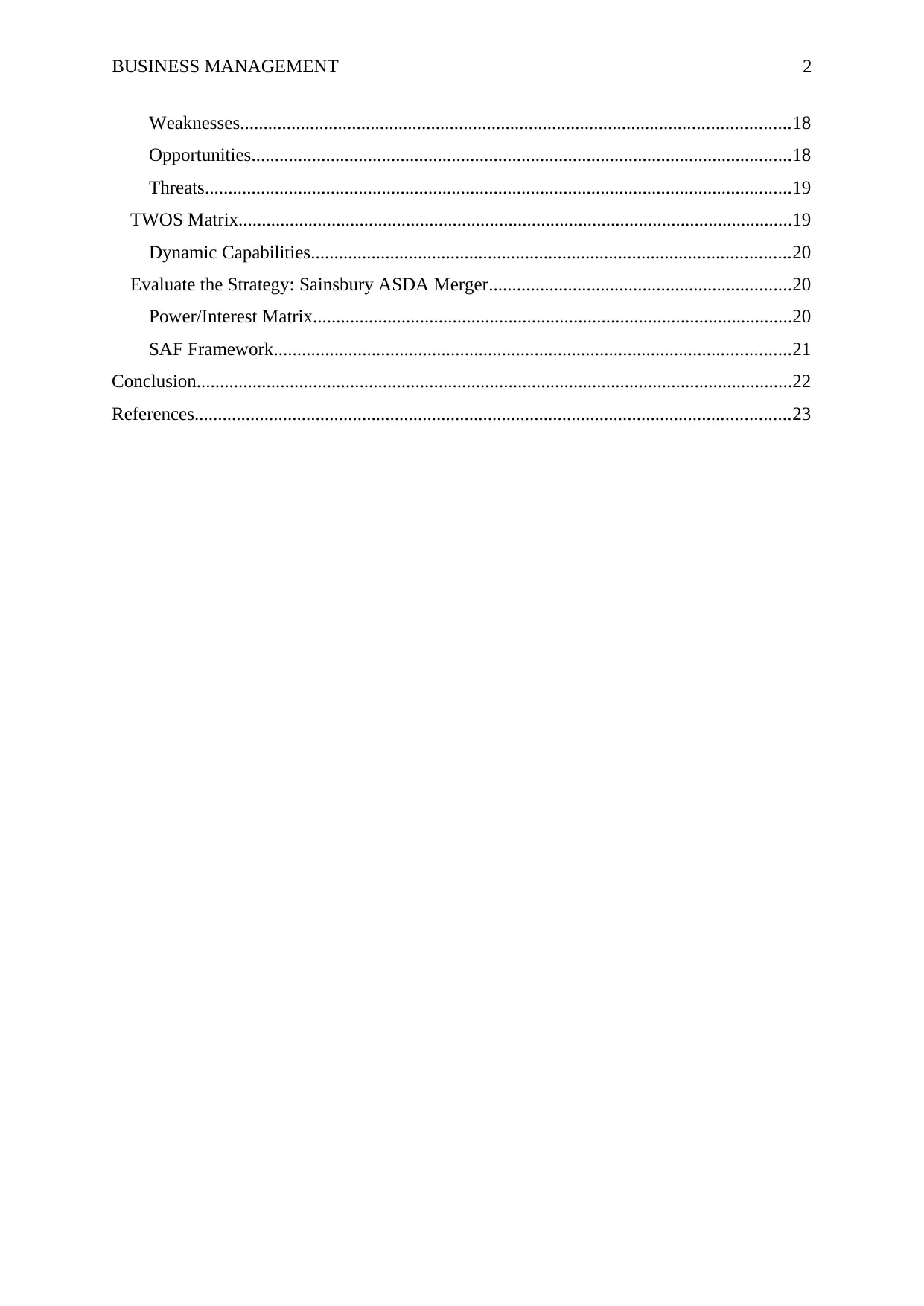
BUSINESS MANAGEMENT 2
Weaknesses......................................................................................................................18
Opportunities....................................................................................................................18
Threats..............................................................................................................................19
TWOS Matrix.......................................................................................................................19
Dynamic Capabilities.......................................................................................................20
Evaluate the Strategy: Sainsbury ASDA Merger.................................................................20
Power/Interest Matrix.......................................................................................................20
SAF Framework...............................................................................................................21
Conclusion................................................................................................................................22
References................................................................................................................................23
Weaknesses......................................................................................................................18
Opportunities....................................................................................................................18
Threats..............................................................................................................................19
TWOS Matrix.......................................................................................................................19
Dynamic Capabilities.......................................................................................................20
Evaluate the Strategy: Sainsbury ASDA Merger.................................................................20
Power/Interest Matrix.......................................................................................................20
SAF Framework...............................................................................................................21
Conclusion................................................................................................................................22
References................................................................................................................................23
⊘ This is a preview!⊘
Do you want full access?
Subscribe today to unlock all pages.

Trusted by 1+ million students worldwide
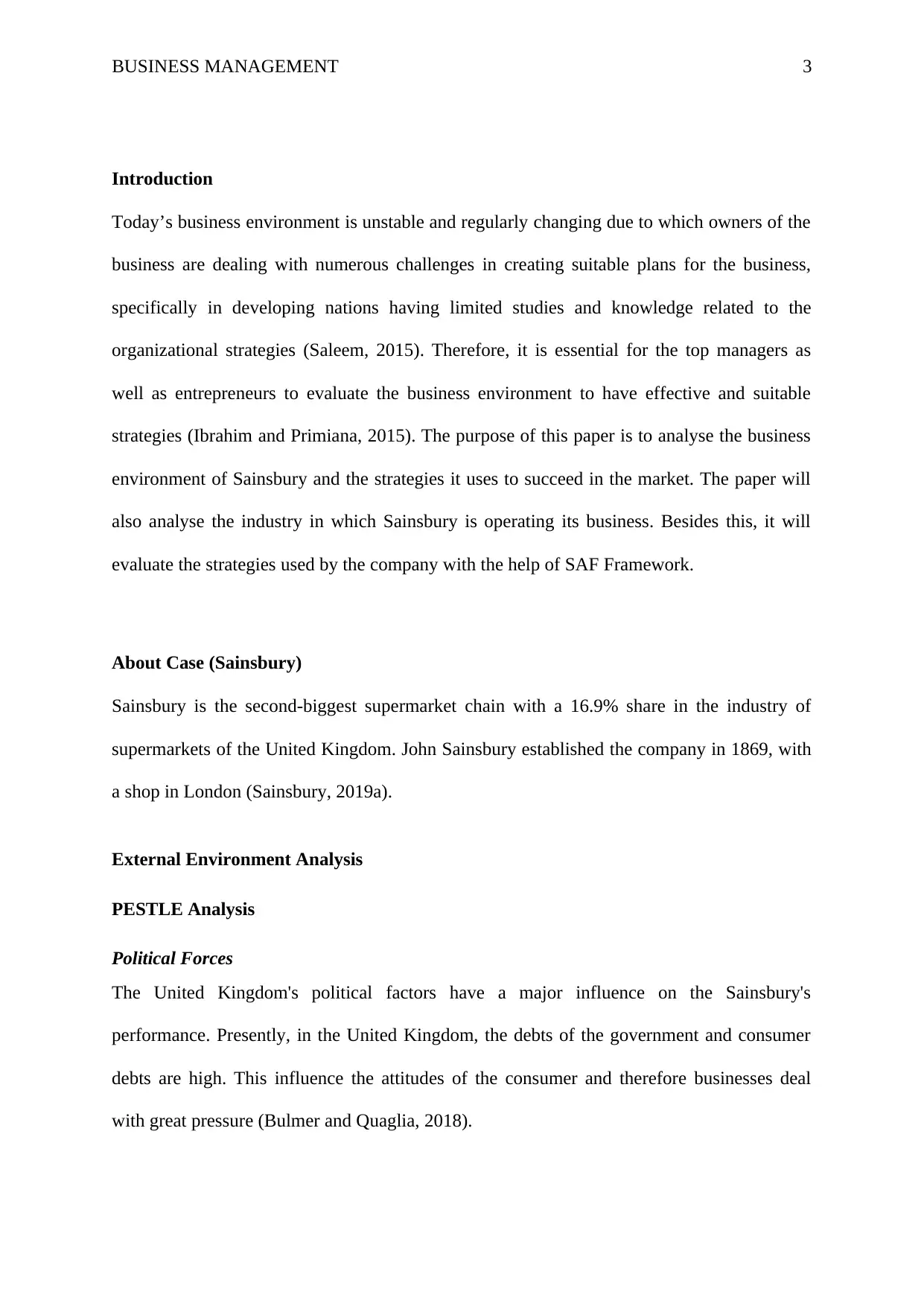
BUSINESS MANAGEMENT 3
Introduction
Today’s business environment is unstable and regularly changing due to which owners of the
business are dealing with numerous challenges in creating suitable plans for the business,
specifically in developing nations having limited studies and knowledge related to the
organizational strategies (Saleem, 2015). Therefore, it is essential for the top managers as
well as entrepreneurs to evaluate the business environment to have effective and suitable
strategies (Ibrahim and Primiana, 2015). The purpose of this paper is to analyse the business
environment of Sainsbury and the strategies it uses to succeed in the market. The paper will
also analyse the industry in which Sainsbury is operating its business. Besides this, it will
evaluate the strategies used by the company with the help of SAF Framework.
About Case (Sainsbury)
Sainsbury is the second-biggest supermarket chain with a 16.9% share in the industry of
supermarkets of the United Kingdom. John Sainsbury established the company in 1869, with
a shop in London (Sainsbury, 2019a).
External Environment Analysis
PESTLE Analysis
Political Forces
The United Kingdom's political factors have a major influence on the Sainsbury's
performance. Presently, in the United Kingdom, the debts of the government and consumer
debts are high. This influence the attitudes of the consumer and therefore businesses deal
with great pressure (Bulmer and Quaglia, 2018).
Introduction
Today’s business environment is unstable and regularly changing due to which owners of the
business are dealing with numerous challenges in creating suitable plans for the business,
specifically in developing nations having limited studies and knowledge related to the
organizational strategies (Saleem, 2015). Therefore, it is essential for the top managers as
well as entrepreneurs to evaluate the business environment to have effective and suitable
strategies (Ibrahim and Primiana, 2015). The purpose of this paper is to analyse the business
environment of Sainsbury and the strategies it uses to succeed in the market. The paper will
also analyse the industry in which Sainsbury is operating its business. Besides this, it will
evaluate the strategies used by the company with the help of SAF Framework.
About Case (Sainsbury)
Sainsbury is the second-biggest supermarket chain with a 16.9% share in the industry of
supermarkets of the United Kingdom. John Sainsbury established the company in 1869, with
a shop in London (Sainsbury, 2019a).
External Environment Analysis
PESTLE Analysis
Political Forces
The United Kingdom's political factors have a major influence on the Sainsbury's
performance. Presently, in the United Kingdom, the debts of the government and consumer
debts are high. This influence the attitudes of the consumer and therefore businesses deal
with great pressure (Bulmer and Quaglia, 2018).
Paraphrase This Document
Need a fresh take? Get an instant paraphrase of this document with our AI Paraphraser
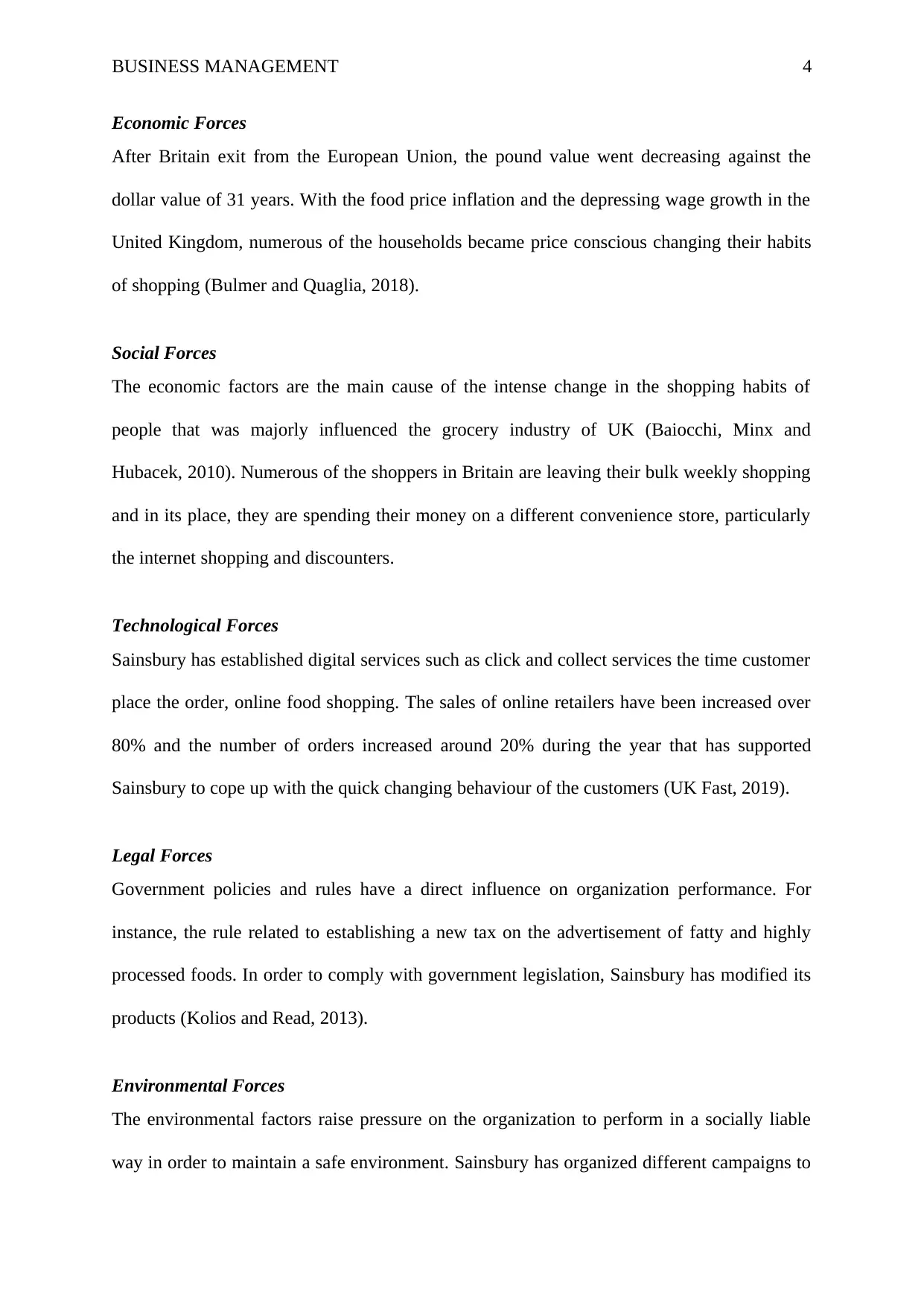
BUSINESS MANAGEMENT 4
Economic Forces
After Britain exit from the European Union, the pound value went decreasing against the
dollar value of 31 years. With the food price inflation and the depressing wage growth in the
United Kingdom, numerous of the households became price conscious changing their habits
of shopping (Bulmer and Quaglia, 2018).
Social Forces
The economic factors are the main cause of the intense change in the shopping habits of
people that was majorly influenced the grocery industry of UK (Baiocchi, Minx and
Hubacek, 2010). Numerous of the shoppers in Britain are leaving their bulk weekly shopping
and in its place, they are spending their money on a different convenience store, particularly
the internet shopping and discounters.
Technological Forces
Sainsbury has established digital services such as click and collect services the time customer
place the order, online food shopping. The sales of online retailers have been increased over
80% and the number of orders increased around 20% during the year that has supported
Sainsbury to cope up with the quick changing behaviour of the customers (UK Fast, 2019).
Legal Forces
Government policies and rules have a direct influence on organization performance. For
instance, the rule related to establishing a new tax on the advertisement of fatty and highly
processed foods. In order to comply with government legislation, Sainsbury has modified its
products (Kolios and Read, 2013).
Environmental Forces
The environmental factors raise pressure on the organization to perform in a socially liable
way in order to maintain a safe environment. Sainsbury has organized different campaigns to
Economic Forces
After Britain exit from the European Union, the pound value went decreasing against the
dollar value of 31 years. With the food price inflation and the depressing wage growth in the
United Kingdom, numerous of the households became price conscious changing their habits
of shopping (Bulmer and Quaglia, 2018).
Social Forces
The economic factors are the main cause of the intense change in the shopping habits of
people that was majorly influenced the grocery industry of UK (Baiocchi, Minx and
Hubacek, 2010). Numerous of the shoppers in Britain are leaving their bulk weekly shopping
and in its place, they are spending their money on a different convenience store, particularly
the internet shopping and discounters.
Technological Forces
Sainsbury has established digital services such as click and collect services the time customer
place the order, online food shopping. The sales of online retailers have been increased over
80% and the number of orders increased around 20% during the year that has supported
Sainsbury to cope up with the quick changing behaviour of the customers (UK Fast, 2019).
Legal Forces
Government policies and rules have a direct influence on organization performance. For
instance, the rule related to establishing a new tax on the advertisement of fatty and highly
processed foods. In order to comply with government legislation, Sainsbury has modified its
products (Kolios and Read, 2013).
Environmental Forces
The environmental factors raise pressure on the organization to perform in a socially liable
way in order to maintain a safe environment. Sainsbury has organized different campaigns to
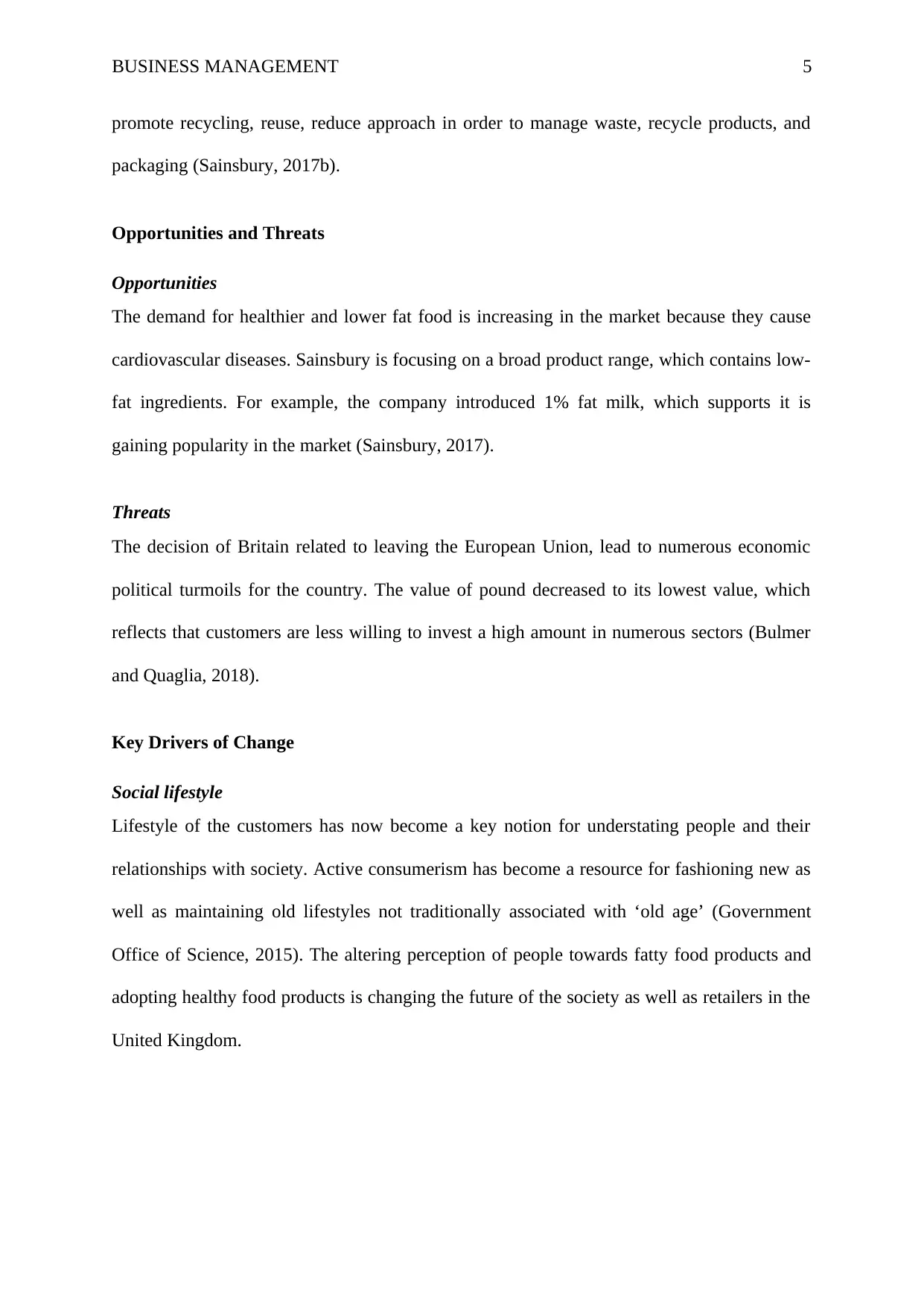
BUSINESS MANAGEMENT 5
promote recycling, reuse, reduce approach in order to manage waste, recycle products, and
packaging (Sainsbury, 2017b).
Opportunities and Threats
Opportunities
The demand for healthier and lower fat food is increasing in the market because they cause
cardiovascular diseases. Sainsbury is focusing on a broad product range, which contains low-
fat ingredients. For example, the company introduced 1% fat milk, which supports it is
gaining popularity in the market (Sainsbury, 2017).
Threats
The decision of Britain related to leaving the European Union, lead to numerous economic
political turmoils for the country. The value of pound decreased to its lowest value, which
reflects that customers are less willing to invest a high amount in numerous sectors (Bulmer
and Quaglia, 2018).
Key Drivers of Change
Social lifestyle
Lifestyle of the customers has now become a key notion for understating people and their
relationships with society. Active consumerism has become a resource for fashioning new as
well as maintaining old lifestyles not traditionally associated with ‘old age’ (Government
Office of Science, 2015). The altering perception of people towards fatty food products and
adopting healthy food products is changing the future of the society as well as retailers in the
United Kingdom.
promote recycling, reuse, reduce approach in order to manage waste, recycle products, and
packaging (Sainsbury, 2017b).
Opportunities and Threats
Opportunities
The demand for healthier and lower fat food is increasing in the market because they cause
cardiovascular diseases. Sainsbury is focusing on a broad product range, which contains low-
fat ingredients. For example, the company introduced 1% fat milk, which supports it is
gaining popularity in the market (Sainsbury, 2017).
Threats
The decision of Britain related to leaving the European Union, lead to numerous economic
political turmoils for the country. The value of pound decreased to its lowest value, which
reflects that customers are less willing to invest a high amount in numerous sectors (Bulmer
and Quaglia, 2018).
Key Drivers of Change
Social lifestyle
Lifestyle of the customers has now become a key notion for understating people and their
relationships with society. Active consumerism has become a resource for fashioning new as
well as maintaining old lifestyles not traditionally associated with ‘old age’ (Government
Office of Science, 2015). The altering perception of people towards fatty food products and
adopting healthy food products is changing the future of the society as well as retailers in the
United Kingdom.
⊘ This is a preview!⊘
Do you want full access?
Subscribe today to unlock all pages.

Trusted by 1+ million students worldwide
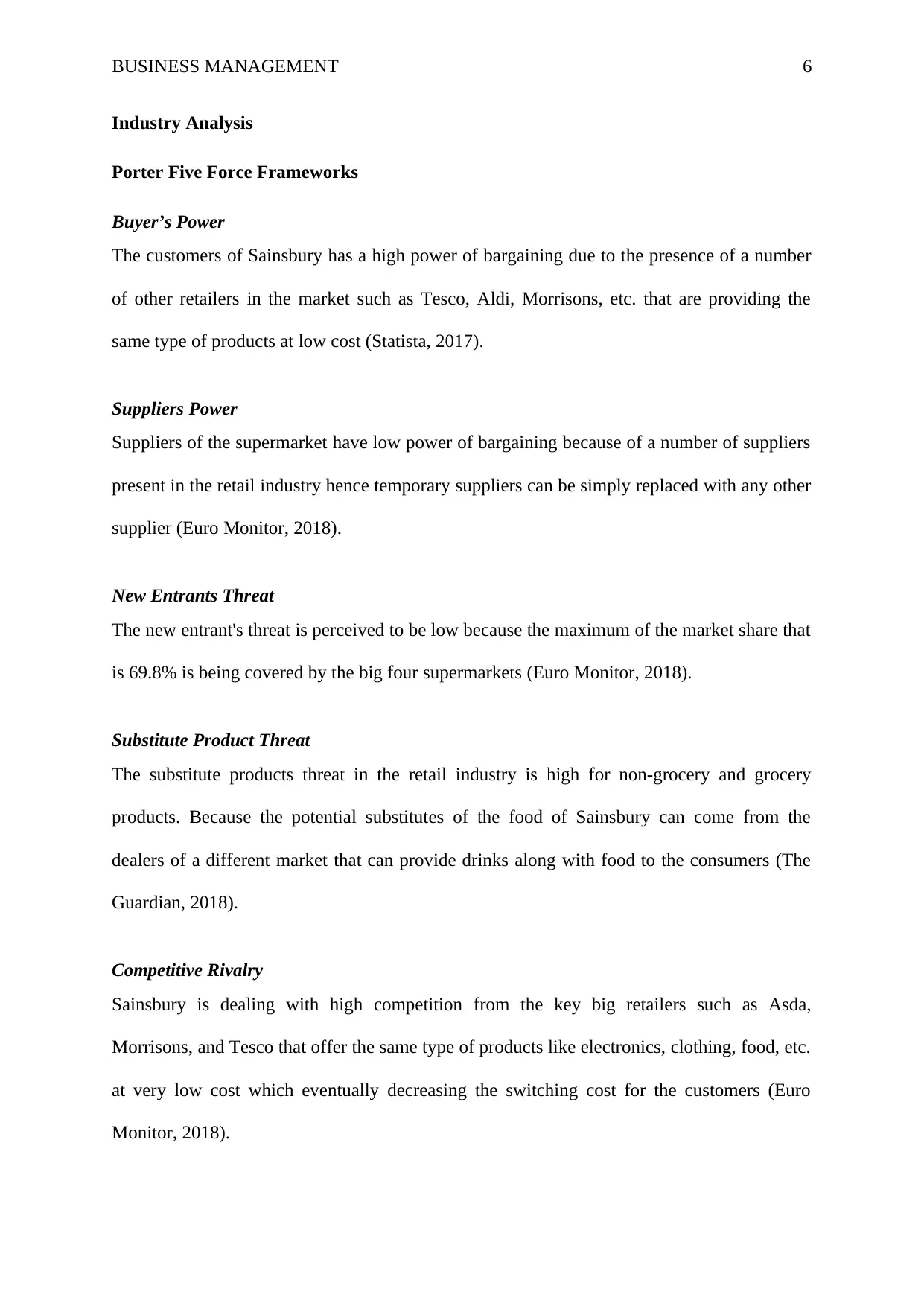
BUSINESS MANAGEMENT 6
Industry Analysis
Porter Five Force Frameworks
Buyer’s Power
The customers of Sainsbury has a high power of bargaining due to the presence of a number
of other retailers in the market such as Tesco, Aldi, Morrisons, etc. that are providing the
same type of products at low cost (Statista, 2017).
Suppliers Power
Suppliers of the supermarket have low power of bargaining because of a number of suppliers
present in the retail industry hence temporary suppliers can be simply replaced with any other
supplier (Euro Monitor, 2018).
New Entrants Threat
The new entrant's threat is perceived to be low because the maximum of the market share that
is 69.8% is being covered by the big four supermarkets (Euro Monitor, 2018).
Substitute Product Threat
The substitute products threat in the retail industry is high for non-grocery and grocery
products. Because the potential substitutes of the food of Sainsbury can come from the
dealers of a different market that can provide drinks along with food to the consumers (The
Guardian, 2018).
Competitive Rivalry
Sainsbury is dealing with high competition from the key big retailers such as Asda,
Morrisons, and Tesco that offer the same type of products like electronics, clothing, food, etc.
at very low cost which eventually decreasing the switching cost for the customers (Euro
Monitor, 2018).
Industry Analysis
Porter Five Force Frameworks
Buyer’s Power
The customers of Sainsbury has a high power of bargaining due to the presence of a number
of other retailers in the market such as Tesco, Aldi, Morrisons, etc. that are providing the
same type of products at low cost (Statista, 2017).
Suppliers Power
Suppliers of the supermarket have low power of bargaining because of a number of suppliers
present in the retail industry hence temporary suppliers can be simply replaced with any other
supplier (Euro Monitor, 2018).
New Entrants Threat
The new entrant's threat is perceived to be low because the maximum of the market share that
is 69.8% is being covered by the big four supermarkets (Euro Monitor, 2018).
Substitute Product Threat
The substitute products threat in the retail industry is high for non-grocery and grocery
products. Because the potential substitutes of the food of Sainsbury can come from the
dealers of a different market that can provide drinks along with food to the consumers (The
Guardian, 2018).
Competitive Rivalry
Sainsbury is dealing with high competition from the key big retailers such as Asda,
Morrisons, and Tesco that offer the same type of products like electronics, clothing, food, etc.
at very low cost which eventually decreasing the switching cost for the customers (Euro
Monitor, 2018).
Paraphrase This Document
Need a fresh take? Get an instant paraphrase of this document with our AI Paraphraser
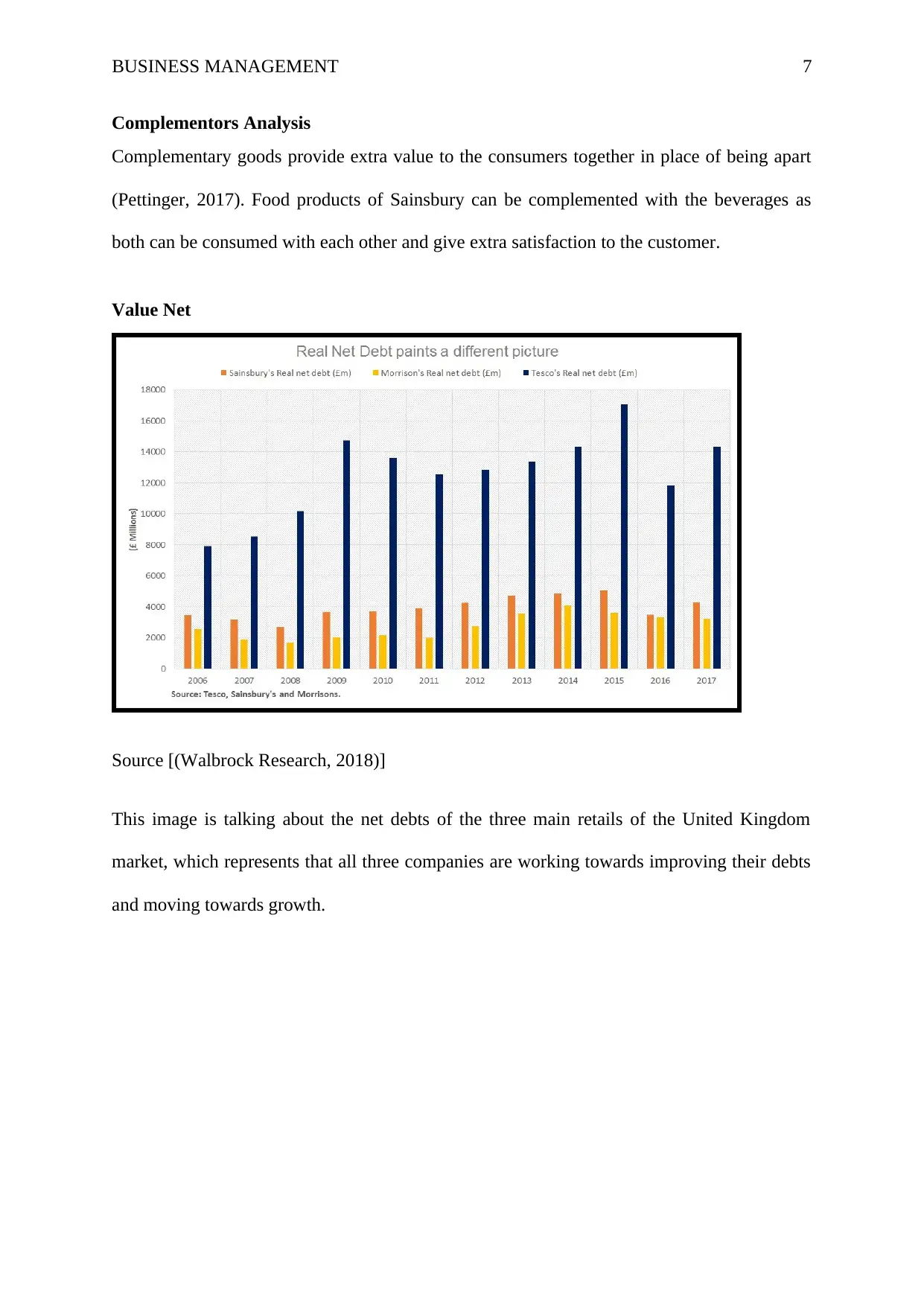
BUSINESS MANAGEMENT 7
Complementors Analysis
Complementary goods provide extra value to the consumers together in place of being apart
(Pettinger, 2017). Food products of Sainsbury can be complemented with the beverages as
both can be consumed with each other and give extra satisfaction to the customer.
Value Net
Source [(Walbrock Research, 2018)]
This image is talking about the net debts of the three main retails of the United Kingdom
market, which represents that all three companies are working towards improving their debts
and moving towards growth.
Complementors Analysis
Complementary goods provide extra value to the consumers together in place of being apart
(Pettinger, 2017). Food products of Sainsbury can be complemented with the beverages as
both can be consumed with each other and give extra satisfaction to the customer.
Value Net
Source [(Walbrock Research, 2018)]
This image is talking about the net debts of the three main retails of the United Kingdom
market, which represents that all three companies are working towards improving their debts
and moving towards growth.
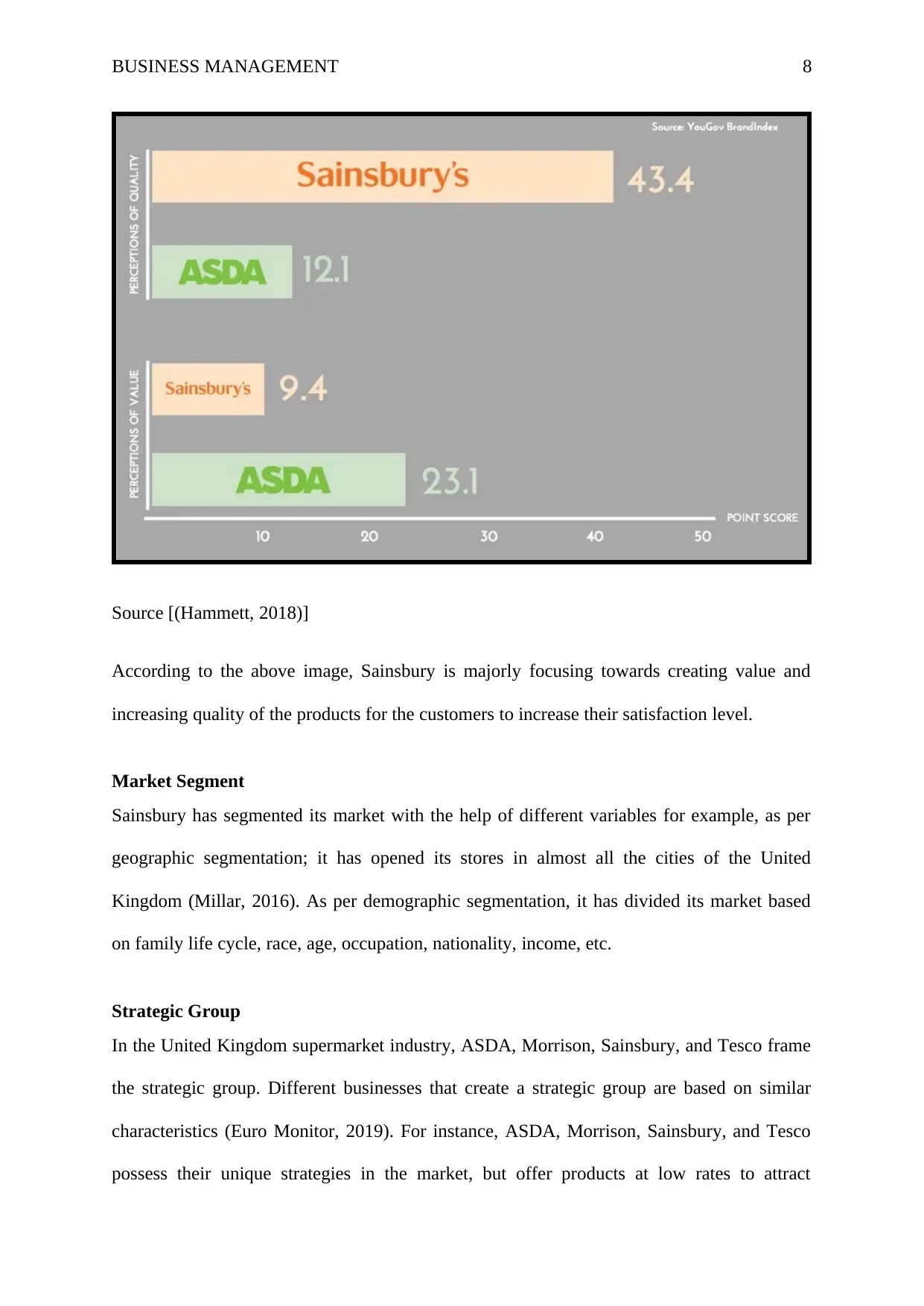
BUSINESS MANAGEMENT 8
Source [(Hammett, 2018)]
According to the above image, Sainsbury is majorly focusing towards creating value and
increasing quality of the products for the customers to increase their satisfaction level.
Market Segment
Sainsbury has segmented its market with the help of different variables for example, as per
geographic segmentation; it has opened its stores in almost all the cities of the United
Kingdom (Millar, 2016). As per demographic segmentation, it has divided its market based
on family life cycle, race, age, occupation, nationality, income, etc.
Strategic Group
In the United Kingdom supermarket industry, ASDA, Morrison, Sainsbury, and Tesco frame
the strategic group. Different businesses that create a strategic group are based on similar
characteristics (Euro Monitor, 2019). For instance, ASDA, Morrison, Sainsbury, and Tesco
possess their unique strategies in the market, but offer products at low rates to attract
Source [(Hammett, 2018)]
According to the above image, Sainsbury is majorly focusing towards creating value and
increasing quality of the products for the customers to increase their satisfaction level.
Market Segment
Sainsbury has segmented its market with the help of different variables for example, as per
geographic segmentation; it has opened its stores in almost all the cities of the United
Kingdom (Millar, 2016). As per demographic segmentation, it has divided its market based
on family life cycle, race, age, occupation, nationality, income, etc.
Strategic Group
In the United Kingdom supermarket industry, ASDA, Morrison, Sainsbury, and Tesco frame
the strategic group. Different businesses that create a strategic group are based on similar
characteristics (Euro Monitor, 2019). For instance, ASDA, Morrison, Sainsbury, and Tesco
possess their unique strategies in the market, but offer products at low rates to attract
⊘ This is a preview!⊘
Do you want full access?
Subscribe today to unlock all pages.

Trusted by 1+ million students worldwide
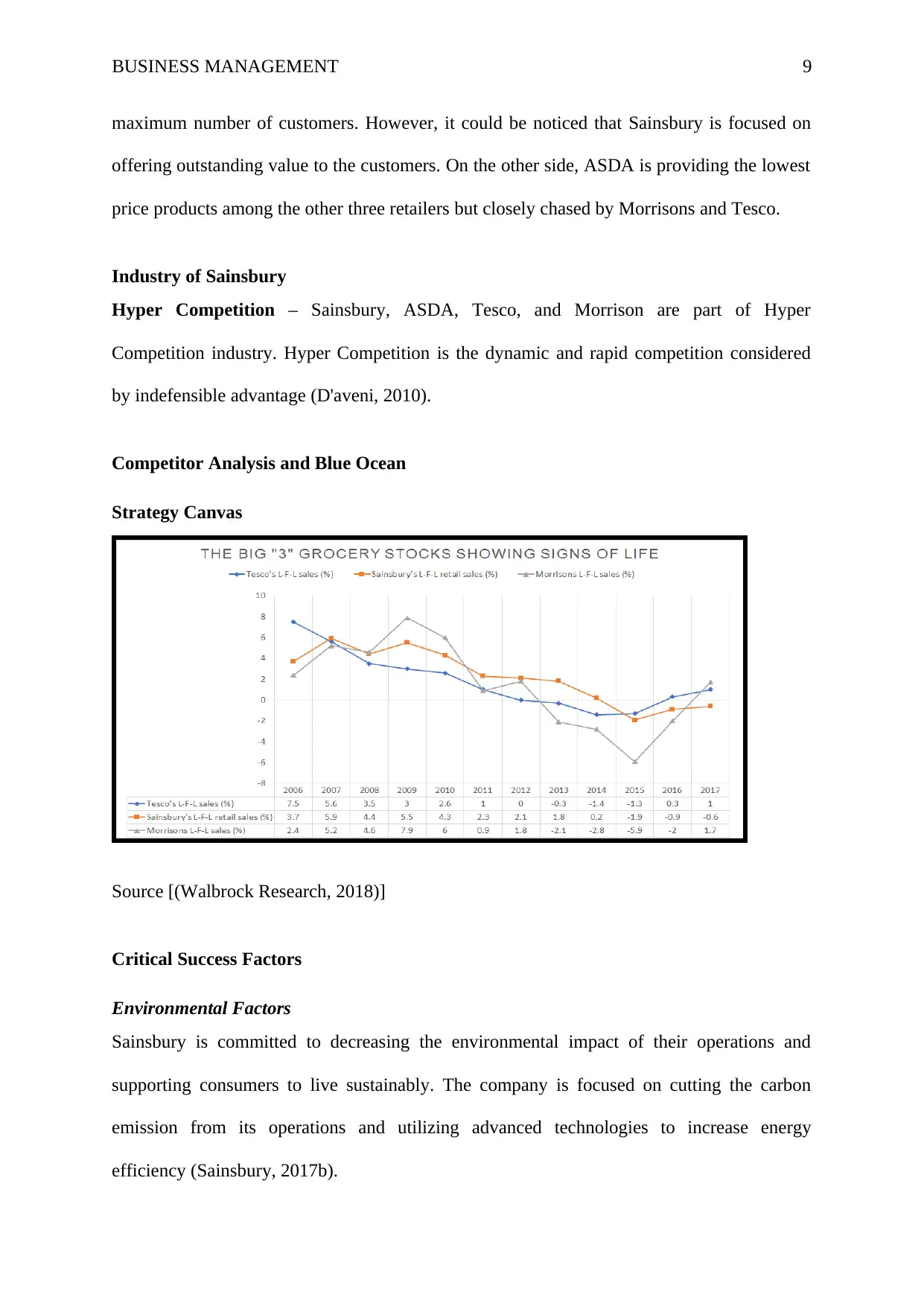
BUSINESS MANAGEMENT 9
maximum number of customers. However, it could be noticed that Sainsbury is focused on
offering outstanding value to the customers. On the other side, ASDA is providing the lowest
price products among the other three retailers but closely chased by Morrisons and Tesco.
Industry of Sainsbury
Hyper Competition – Sainsbury, ASDA, Tesco, and Morrison are part of Hyper
Competition industry. Hyper Competition is the dynamic and rapid competition considered
by indefensible advantage (D'aveni, 2010).
Competitor Analysis and Blue Ocean
Strategy Canvas
Source [(Walbrock Research, 2018)]
Critical Success Factors
Environmental Factors
Sainsbury is committed to decreasing the environmental impact of their operations and
supporting consumers to live sustainably. The company is focused on cutting the carbon
emission from its operations and utilizing advanced technologies to increase energy
efficiency (Sainsbury, 2017b).
maximum number of customers. However, it could be noticed that Sainsbury is focused on
offering outstanding value to the customers. On the other side, ASDA is providing the lowest
price products among the other three retailers but closely chased by Morrisons and Tesco.
Industry of Sainsbury
Hyper Competition – Sainsbury, ASDA, Tesco, and Morrison are part of Hyper
Competition industry. Hyper Competition is the dynamic and rapid competition considered
by indefensible advantage (D'aveni, 2010).
Competitor Analysis and Blue Ocean
Strategy Canvas
Source [(Walbrock Research, 2018)]
Critical Success Factors
Environmental Factors
Sainsbury is committed to decreasing the environmental impact of their operations and
supporting consumers to live sustainably. The company is focused on cutting the carbon
emission from its operations and utilizing advanced technologies to increase energy
efficiency (Sainsbury, 2017b).
Paraphrase This Document
Need a fresh take? Get an instant paraphrase of this document with our AI Paraphraser
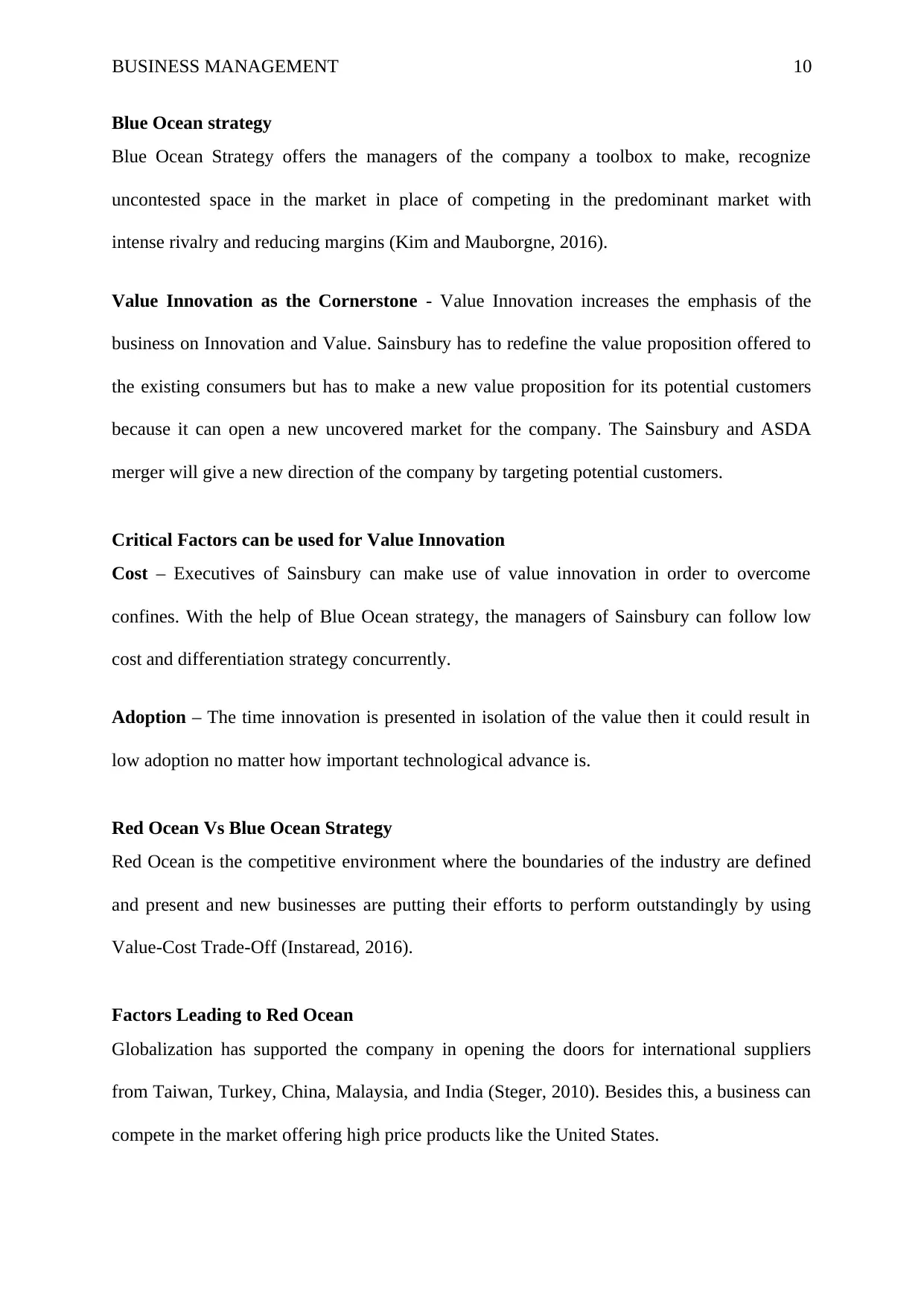
BUSINESS MANAGEMENT 10
Blue Ocean strategy
Blue Ocean Strategy offers the managers of the company a toolbox to make, recognize
uncontested space in the market in place of competing in the predominant market with
intense rivalry and reducing margins (Kim and Mauborgne, 2016).
Value Innovation as the Cornerstone - Value Innovation increases the emphasis of the
business on Innovation and Value. Sainsbury has to redefine the value proposition offered to
the existing consumers but has to make a new value proposition for its potential customers
because it can open a new uncovered market for the company. The Sainsbury and ASDA
merger will give a new direction of the company by targeting potential customers.
Critical Factors can be used for Value Innovation
Cost – Executives of Sainsbury can make use of value innovation in order to overcome
confines. With the help of Blue Ocean strategy, the managers of Sainsbury can follow low
cost and differentiation strategy concurrently.
Adoption – The time innovation is presented in isolation of the value then it could result in
low adoption no matter how important technological advance is.
Red Ocean Vs Blue Ocean Strategy
Red Ocean is the competitive environment where the boundaries of the industry are defined
and present and new businesses are putting their efforts to perform outstandingly by using
Value-Cost Trade-Off (Instaread, 2016).
Factors Leading to Red Ocean
Globalization has supported the company in opening the doors for international suppliers
from Taiwan, Turkey, China, Malaysia, and India (Steger, 2010). Besides this, a business can
compete in the market offering high price products like the United States.
Blue Ocean strategy
Blue Ocean Strategy offers the managers of the company a toolbox to make, recognize
uncontested space in the market in place of competing in the predominant market with
intense rivalry and reducing margins (Kim and Mauborgne, 2016).
Value Innovation as the Cornerstone - Value Innovation increases the emphasis of the
business on Innovation and Value. Sainsbury has to redefine the value proposition offered to
the existing consumers but has to make a new value proposition for its potential customers
because it can open a new uncovered market for the company. The Sainsbury and ASDA
merger will give a new direction of the company by targeting potential customers.
Critical Factors can be used for Value Innovation
Cost – Executives of Sainsbury can make use of value innovation in order to overcome
confines. With the help of Blue Ocean strategy, the managers of Sainsbury can follow low
cost and differentiation strategy concurrently.
Adoption – The time innovation is presented in isolation of the value then it could result in
low adoption no matter how important technological advance is.
Red Ocean Vs Blue Ocean Strategy
Red Ocean is the competitive environment where the boundaries of the industry are defined
and present and new businesses are putting their efforts to perform outstandingly by using
Value-Cost Trade-Off (Instaread, 2016).
Factors Leading to Red Ocean
Globalization has supported the company in opening the doors for international suppliers
from Taiwan, Turkey, China, Malaysia, and India (Steger, 2010). Besides this, a business can
compete in the market offering high price products like the United States.
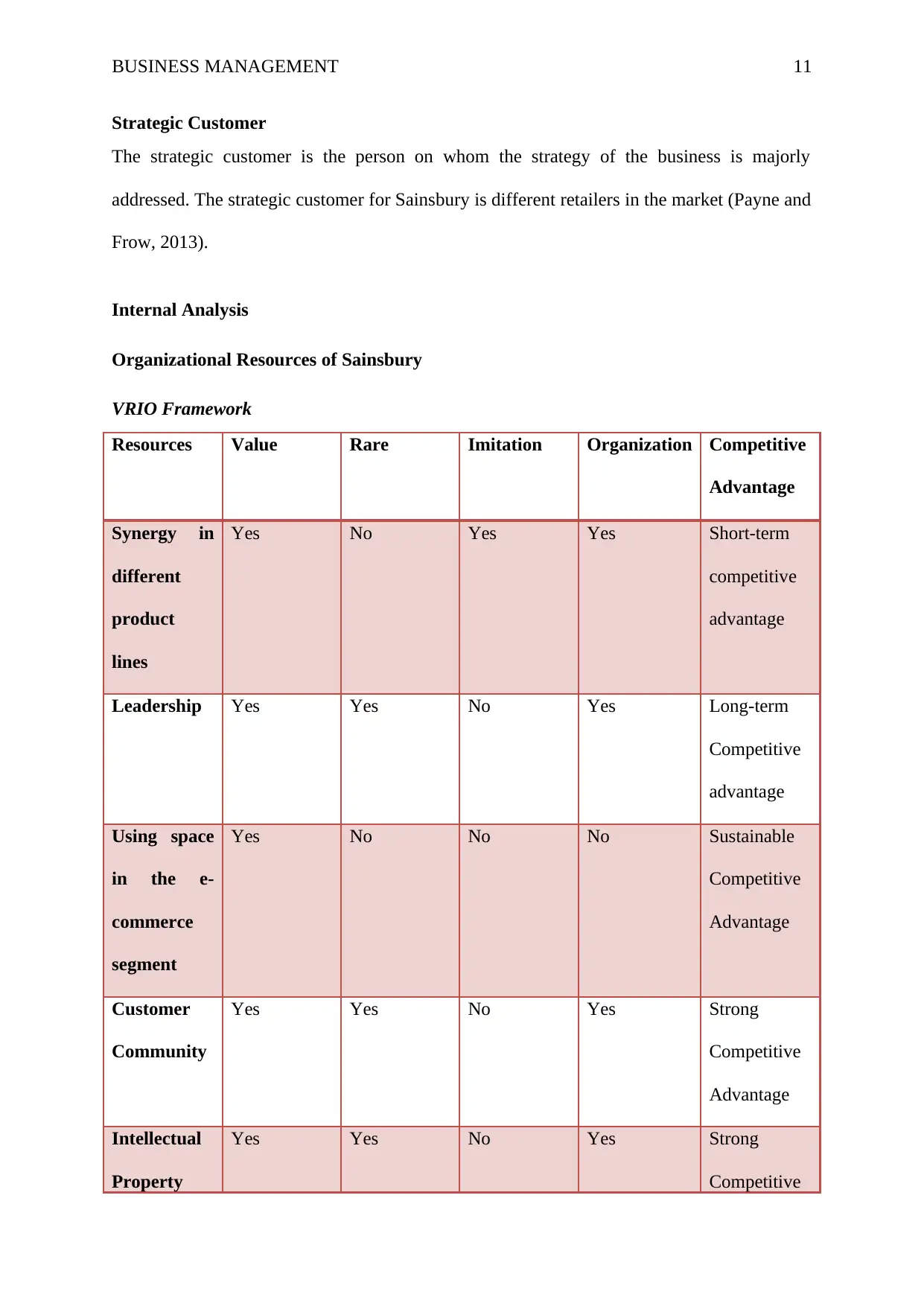
BUSINESS MANAGEMENT 11
Strategic Customer
The strategic customer is the person on whom the strategy of the business is majorly
addressed. The strategic customer for Sainsbury is different retailers in the market (Payne and
Frow, 2013).
Internal Analysis
Organizational Resources of Sainsbury
VRIO Framework
Resources Value Rare Imitation Organization Competitive
Advantage
Synergy in
different
product
lines
Yes No Yes Yes Short-term
competitive
advantage
Leadership Yes Yes No Yes Long-term
Competitive
advantage
Using space
in the e-
commerce
segment
Yes No No No Sustainable
Competitive
Advantage
Customer
Community
Yes Yes No Yes Strong
Competitive
Advantage
Intellectual
Property
Yes Yes No Yes Strong
Competitive
Strategic Customer
The strategic customer is the person on whom the strategy of the business is majorly
addressed. The strategic customer for Sainsbury is different retailers in the market (Payne and
Frow, 2013).
Internal Analysis
Organizational Resources of Sainsbury
VRIO Framework
Resources Value Rare Imitation Organization Competitive
Advantage
Synergy in
different
product
lines
Yes No Yes Yes Short-term
competitive
advantage
Leadership Yes Yes No Yes Long-term
Competitive
advantage
Using space
in the e-
commerce
segment
Yes No No No Sustainable
Competitive
Advantage
Customer
Community
Yes Yes No Yes Strong
Competitive
Advantage
Intellectual
Property
Yes Yes No Yes Strong
Competitive
⊘ This is a preview!⊘
Do you want full access?
Subscribe today to unlock all pages.

Trusted by 1+ million students worldwide
1 out of 28
Related Documents
Your All-in-One AI-Powered Toolkit for Academic Success.
+13062052269
info@desklib.com
Available 24*7 on WhatsApp / Email
![[object Object]](/_next/static/media/star-bottom.7253800d.svg)
Unlock your academic potential
Copyright © 2020–2025 A2Z Services. All Rights Reserved. Developed and managed by ZUCOL.




